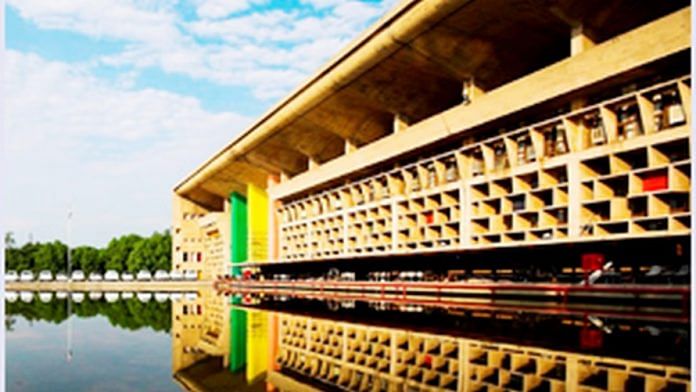Gurugram: The Punjab and Haryana High Court has asked the Chandigarh Administration to produce documents of the environment clearance given to Hotel Lalit at Rajiv Gandhi InfoTech (IT) Park, after the UT administration raised ecological concerns over the construction of a new High Court building at the same spot.
A Division Bench of the Punjab and Haryana High Court headed by Chief Justice Sheel Nagu and Justice Sanjiv Berry ordered the Chandigarh Union Territory (UT) Administration to provide records of the permission granted for construction of Hotel Lalit at the Rajiv Gandhi InfoTech (IT) Park in response to the UT Administration’s objections to a new High Court building there, citing its proximity to the path of migratory birds to Sukhna Lake.
The order came on 1 August 2025, in the ongoing case of Vinod Dhattewal and Others vs. Union of India and Others, regarding long-standing infrastructural limitations at the present location of the High Court in Sector 1, Chandigarh.
The court building, which is part of the UNESCO World Heritage-listed Capitol Complex, is constrained from being extended due to its heritage status and the fact that it is situated within the catchment area of Sukhna Lake.
Interestingly, this is the second time the Chandigarh Administration has invited the High Court’s tough stance in this particular case. The first instance was when the court issued notice of contempt to chief engineer CB Ojha on 13 December 2024 when the administration failed to build a verandah outside room number one, the CJ’s court, despite the court’s repeated directions, citing a threat to the building’s UNESCO World Heritage status.
However, when the Chandigarh Administration approached the Supreme Court against the contempt notice, the apex court, after staying the HC directions initially, had ruled in May that the heritage status of the Capital Complex was not affected by the construction of a verandah.
In its verdict, the Division Bench of the Supreme Court comprising Justices Vikram Nath and Sandeep Mehta, rejected the Chandigarh Administration’s appeal that flagged potential risks to the complex’s UNESCO World Heritage status.
The present case
In its 1 August order, the Division Bench has asked for certain documents to examine the UT Administration’s position on environmental limitations in the IT Park zone.
The Bench asked the administration to submit documentary evidence of environmental objections presented by the Wildlife Board against construction in the IT Park, which is below the flight path of migratory birds coming to Sukhna Lake.
The court has also demanded the sanction order issued by the UT Administration and the No Objection Certificate (NOC) documents issued by the environment authorities qua Lalit Hotel.
The High Court noted that initially, a proposal to set up the new building of the High Court at another site at Sarangpur village had also been considered during the hearing of the case.
However, the bench observed that the road to Sarangpur, which goes through Sector 12’s PGIMER square, is in a state of perpetual traffic congestion, especially at peak hours.
The UT Administration’s idea of building an underpass was labelled as possibly not viable, especially during rain.
“Furthermore, with the suggested shifting of the High Court from Sector-1, Chandigarh to village Sarangpur, the entire traffic of Chandigarh as well as Panchkula and partially of Mohali will take the route passing through Sector 12, PGIMER roundabout for accessing village Sarangpur,” the court noted in its order.
“This in all probability will induce delay and inconvenience to the Judges, members of the Bar, employees, litigants, as well as other stakeholders,” the court observed.
The court also instructed the High Court Bar Association and the UT Administration to convene a collective meeting on 7 August in the Bar Association Hall, to discuss whether to pursue an alternative location or revisit a prior “holistic plan” for the improvement of the current High Court premises.
The court asked the Additional Solicitor General Satya Pal Jain to chair this meeting in order to facilitate positive discussion.
For this purpose, the court directed the UT Administration to provide all documents necessary for these discussions, including maps and sketches, to the office bearers of the Bar Association.
The administration also asked the administration to file a report on the proceedings of the meeting prior to the next hearing in the case, which will be held on 13 August 2025.
Context of the infrastructure struggle
The Vinod Dhattewal and Others v. Union of India and Others case in the Punjab and Haryana High Court is a public interest litigation (PIL) concerned with the infrastructural problems of the High Court at its existing location in Sector 1, Chandigarh.
The case, which is being heard by a Division Bench consisting Chief Justice Sheel Nagu and Justice Sanjiv Berry, is concerned with questions of space, traffic congestion, and the possibility of shifting or expanding the High Court’s premises, considering that it falls under the UNESCO World Heritage-listed Chandigarh Capitol Complex as well within the Sukhna Lake catchment area.
The fact that the court is situated in the Capitol Complex, which has been designed by Le Corbusier, restricts possibilities for expansion, when the mounting caseload and traffic require more courtrooms, administrative offices, and parking areas.
(Edited by Viny Mishra)
Also read: How a verandah has brought SC and Punjab & Haryana HC on different sides of the same fence






